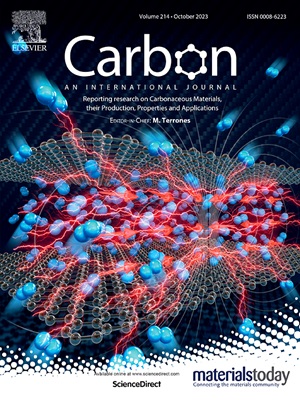Catalyst-mediated etching of carbon nanotubes exhibiting electronic-structure insensitivity and reciprocal kinetics with growth
IF 10.5
2区 材料科学
Q1 CHEMISTRY, PHYSICAL
引用次数: 0
Abstract
The selective etching of carbon nanotubes has been widely explored as a post-synthetic route for enriching semiconducting species. As nanoelectronic applications increasingly demand pure semiconducting nanotubes for use in field-effect transistors and other optoelectronic devices, understanding the mechanistic basis of selective removal becomes critical. While etching selectivity is often attributed to electronic structure effects on tube walls, its relevance in the presence of catalyst nanoparticles remains unclear. Here, we directly quantify the catalyst-mediated etching and growth rates of individual single-walled carbon nanotubes using elaborate isotope labeling methods. Surprisingly, in water vapor and methanol environments, catalytic etching proceeds with negligible dependence on tube electronic type, in sharp contrast to non-catalytic oxidation pathways. In-situ Raman analysis upon heating on nanotube ensembles also confirms metallicity-insensitive etching under catalytic conditions, whereas sidewall oxidation without catalysts exhibits pronounced selectivity. Our growth kinetic model, which precisely describes the kinetics of catalytic etching process, motivates kinetic Monte Carlo simulations of nanotube edge dynamics, revealing the reciprocal nature of edge configuration during growth and etching. These findings highlight a mechanistic difference between catalytic and non-catalytic reactivity and thus propose that catalytic etching may serve as a diagnostic mirror of growth behavior when using pre-sorted carbon nanotube samples.
碳纳米管的催化蚀刻表现出电子结构不敏感和随生长的互反动力学
碳纳米管的选择性蚀刻作为一种富集半导体物质的合成后途径已被广泛探索。随着纳米电子应用越来越多地要求纯半导体纳米管用于场效应晶体管和其他光电器件,了解选择性去除的机制基础变得至关重要。虽然蚀刻选择性通常归因于管壁上的电子结构效应,但其与催化剂纳米颗粒存在的相关性尚不清楚。在这里,我们使用复杂的同位素标记方法直接量化催化剂介导的单个单壁碳纳米管的蚀刻和生长速率。令人惊讶的是,在水蒸气和甲醇环境中,催化蚀刻对电子管类型的依赖可以忽略不计,与非催化氧化途径形成鲜明对比。加热后的原位拉曼分析也证实了催化条件下的金属不敏感蚀刻,而没有催化剂的侧壁氧化表现出明显的选择性。我们的生长动力学模型精确地描述了催化蚀刻过程的动力学,激发了纳米管边缘动力学的动力学蒙特卡罗模拟,揭示了生长和蚀刻过程中边缘构型的互反性质。这些发现强调了催化和非催化反应性之间的机制差异,因此提出在使用预分类碳纳米管样品时,催化蚀刻可以作为生长行为的诊断镜。
本文章由计算机程序翻译,如有差异,请以英文原文为准。
求助全文
约1分钟内获得全文
求助全文
来源期刊

Carbon
工程技术-材料科学:综合
CiteScore
20.80
自引率
7.30%
发文量
0
审稿时长
23 days
期刊介绍:
The journal Carbon is an international multidisciplinary forum for communicating scientific advances in the field of carbon materials. It reports new findings related to the formation, structure, properties, behaviors, and technological applications of carbons. Carbons are a broad class of ordered or disordered solid phases composed primarily of elemental carbon, including but not limited to carbon black, carbon fibers and filaments, carbon nanotubes, diamond and diamond-like carbon, fullerenes, glassy carbon, graphite, graphene, graphene-oxide, porous carbons, pyrolytic carbon, and other sp2 and non-sp2 hybridized carbon systems. Carbon is the companion title to the open access journal Carbon Trends. Relevant application areas for carbon materials include biology and medicine, catalysis, electronic, optoelectronic, spintronic, high-frequency, and photonic devices, energy storage and conversion systems, environmental applications and water treatment, smart materials and systems, and structural and thermal applications.
 求助内容:
求助内容: 应助结果提醒方式:
应助结果提醒方式:


